Featured image: The Mnajdra Prehistoric Temples consists of three buildings, shaped in a figure eight / Photo by Carolyn Ray
With seven ancient megalithic temples on Malta, one has to wonder
by Carolyn Ray
It’s easy to believe that giants once lived in Malta when you visit the massive megalithic temples. Approaching these yellowish towering rocks, which are arranged in half-circles, squares and even figure eights, the only thought in my mind is ‘how on Earth did these get here?’ Now covered by enormous tents to prevent further erosion, these ancient complexes predate Galileo or Copernicus, demonstrating highly advanced societies who worshipped the sun, moon and stars.
But first, what’s a megalith? Until I came to Malta, I had never heard the term ‘megalith’. It is derived from two Greek words (megas=large and lithos=stone. Megalithic refers to ancient construction that used enormous stones of great size. Believe it or not, there are hundreds of megalithic structures in Europe oriented to the solstices and the equinoxes. Malta’s megalithic temples are recognized as some of the most ancient on Earth, described by the UNESCO World Heritage Sites committee as “unique architectural masterpieces”.
It’s easy to see why. Malta is the home of seven megalithic temples, dating back over 5,000 years, which are among the earliest free-standing stone buildings in the world. These include Ġgantija, Ħaġar Qim, Mnajdra, Skorba, Ta’ Ħaġrat and Tarxien. What happened to these civilizations isn’t clear, but what remains is an astonishing array of massive rocks, showing the sheer intelligence of humans thousands of years ago.
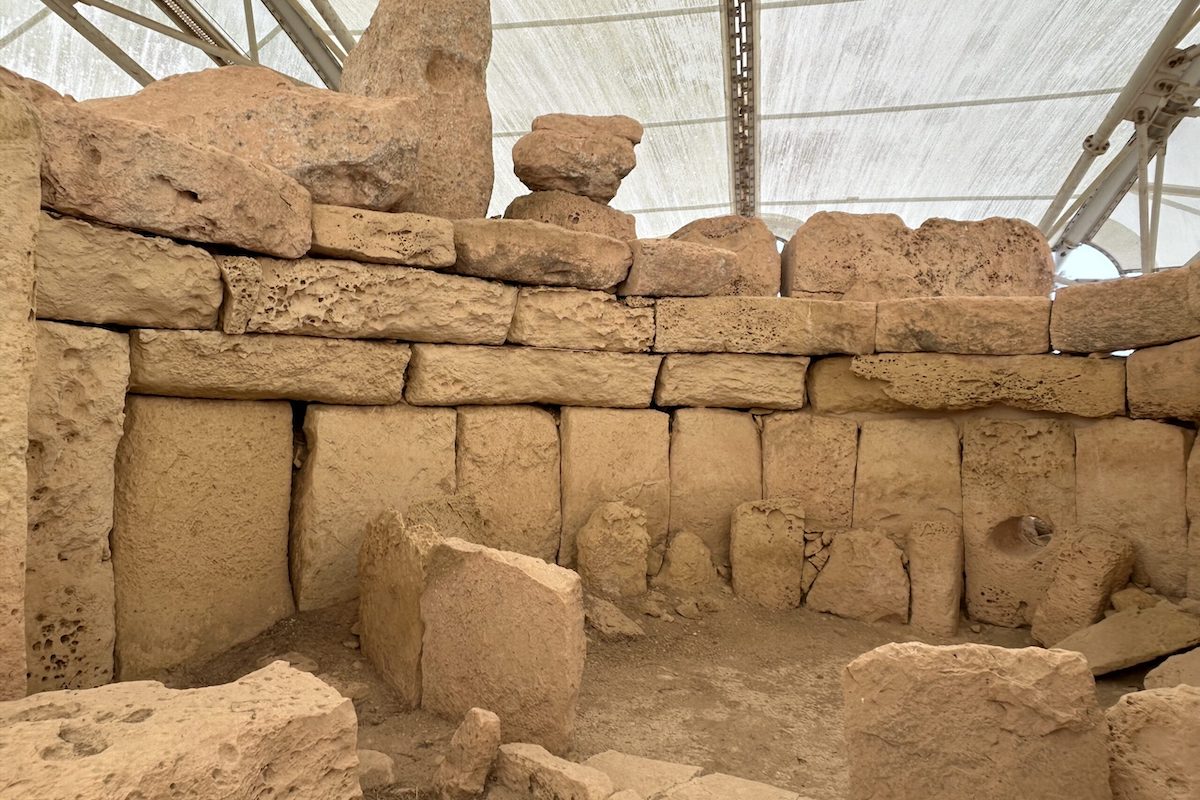
At over 5,000 years old, Hagar Qim, one of Malta’s megalithic temples, is ancient with a main temple and three other structures / Photo by Carolyn Ray
Exploring Malta’s Megalithic Temples
Gozo’s Ggantija
One of the best-known megalithic structures in Malta is Ggantija, a UNESCO world heritage site, which is on the nearby island of Gozo. Ggantija consists of two structures built between c.3600 and c.3200 BC, which are made of locally sourced globigerina and coralline limestone. Next door to this astonishing site, which is in the middle of a field, is the Ta’ Kola Windmill, a 200-year old windmill dating from the Knights’ period.
The ferry to Gozo takes about 25 minutes from the Cirkewwa terminal in North Malta. Upon arrival, there are regular buses that will take you very close to the site, so a car is not needed. Find tickets here.
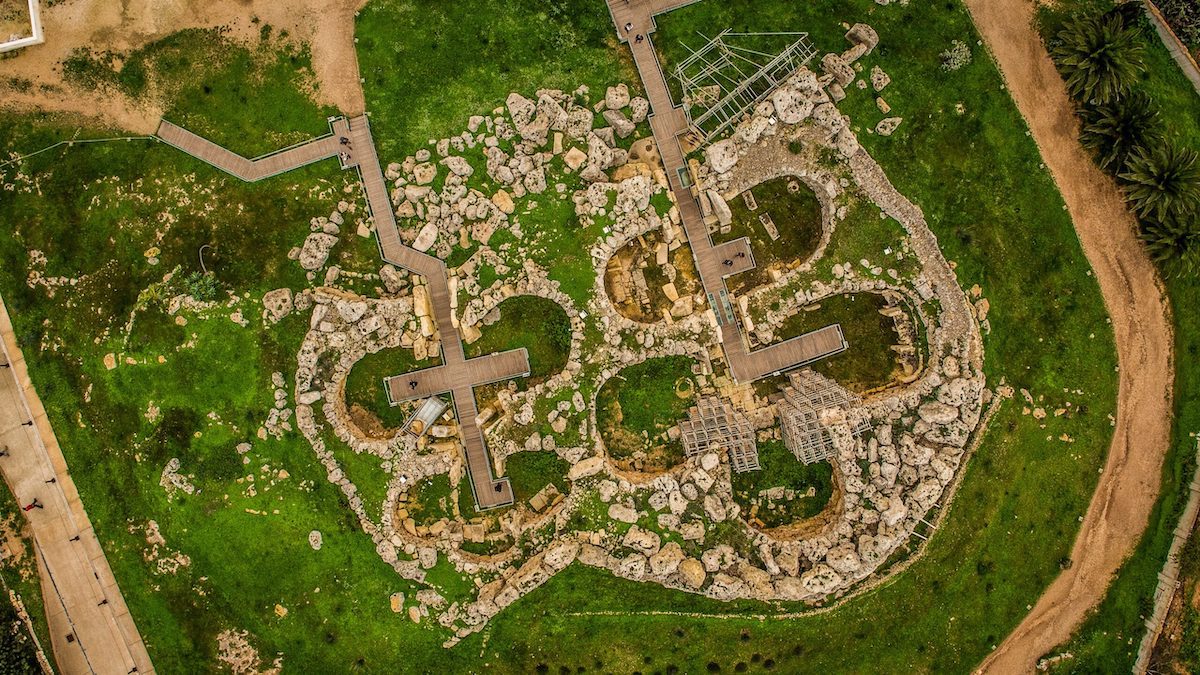
One of the best-known megalithic temples in Malta is Ggantija, a UNESCO world heritage site, on the island of Gozo / Photo by Visit Malta
Hagar Qim and Mnajdra Archaeological Complex
At over 5,000 years old, Hagar Qim is even more ancient, with a main temple and three megalithic structures. The main temple was built between 3600 and 3200 BC., however the northern ruins are even older. Ħaġar Qim took my breath away, particularly as it contains the largest stone used in Maltese megalithic architecture, at 57 tons. How on earth these ancient people moved these enormous rocks remains a mystery.
Just below Hagar Qim, on a grassy plain overlooking the sea, is the Mnajdra Prehistoric Temples, which are just as breathtaking. Mnajdra consists of three buildings, constructed in both globigerina and coralline limestone, shaped in a figure eight. During the winter and summer solstices, the beams of the rising sun pass along the sides of the main doorway hitting two decorated slabs within the first chamber, illuminating the altar. Wouldn’t that be a sight to see!
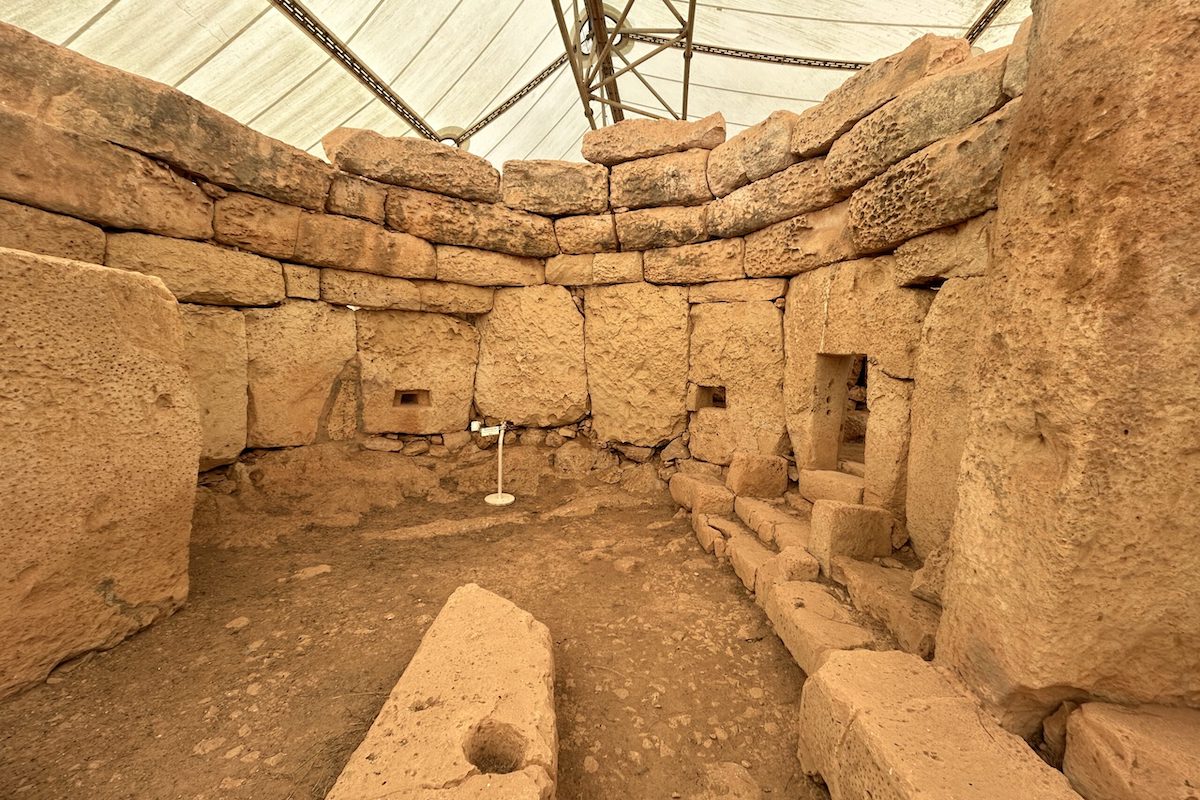
The massive rocks of the Mnajdra Prehistoric Temples/ Photo by Carolyn Ray
Hal Saflieni Hypogeum
Just three miles from Valetta in the small town of Paola is the Hal Saflieni Hypogeum, one of Europe’s only known neolithic necropolises. Dating back thousands of years, it was both a place of worship and burial chambers and was accidently discovered in 1902 when a well was being excavated for a nearby house. UNESCO has inscribed it as “unique testimony to a civilization which has disappeared.”
Archaeologists estimate that over 6000 people were buried at the site, which consists of halls, chambers, passages, stairs and windows hewn out of globogerina limestone. The complex covers an area of about 500 square feet and has three levels: the Upper Level (c. 3600-3000BC0, the Middle Level (3000 – 2500 BC) and the Lower Level (3000 – 2500 BC).
The entrance is a simple door in a small courtyard, with buildings over and beside it. After its discovery, tourists were allowed to visit it for years. Now it has a controlled microclimate and limits visitors to 10 people an hour to ensure that the humidity, temperature and carbon dioxide levels are controlled to protect the unique paintings within the site, such as those in the ‘oracle chamber’.
The cost of conservation is expensive – $35 euros per person for a ‘guided’ tour. While there is a guide that goes with the group, it is really ‘self-guided’ because via a taped recording on headphones, which runs in multiple languages. Protective plastic covers are provided to wear over shoes and there’s no touching anything. Tours have to be booked well in advance.
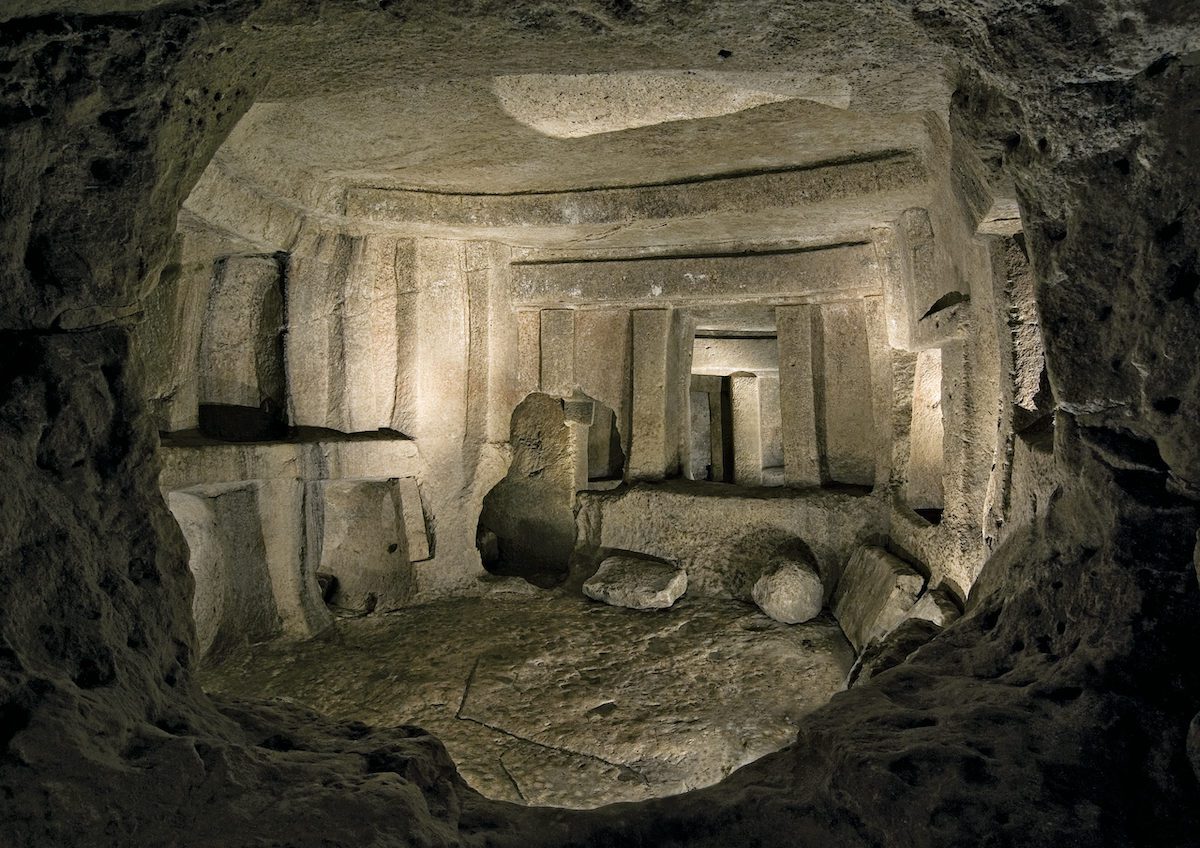
The Hal Saflieni Hypogeum is one of Europe’s only known neolithic necropolises / Photo credit Visit Malta
Tarxien Prehistoric Complex
While at Hal Saflieni, I learned that Tarxien was just down the street. Like the other megalithic complexes, dates back thousands of years, to approximately 3150 BC. Unlike the others, however, it has stonework with depictions of domestic animals including goats, bulls, pigs, and a ram, and rocks decorated with spiral designs.
Discovered in 1914 in a farmer’s field, the discovery of Tarxien confirmed the existence of a thriving ancient culture on the island, creating a strong sense of national pride. Because it wasn’t as well preserved, it also stimulated a culture of conservation.
Read More: Ten Great Books set in the Mediterranean
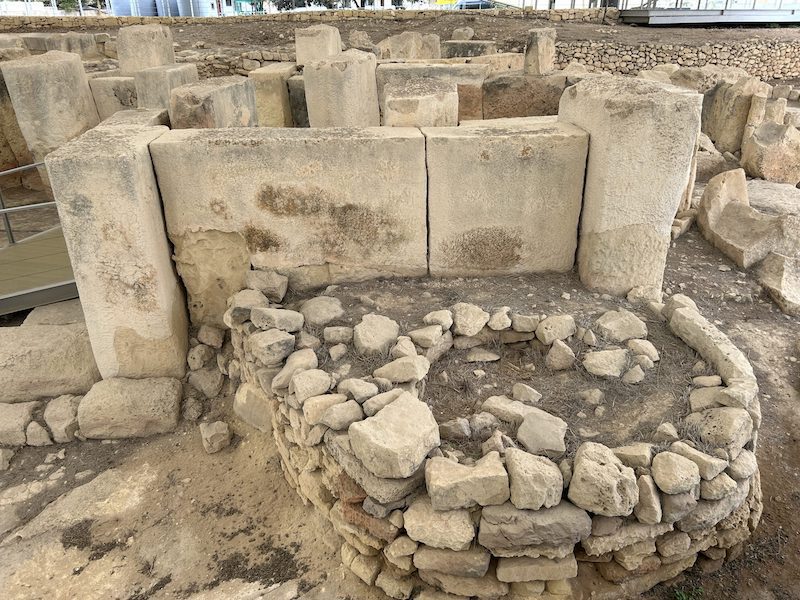
Tarxien Prehistoric Complex/ Photo by Carolyn Ray
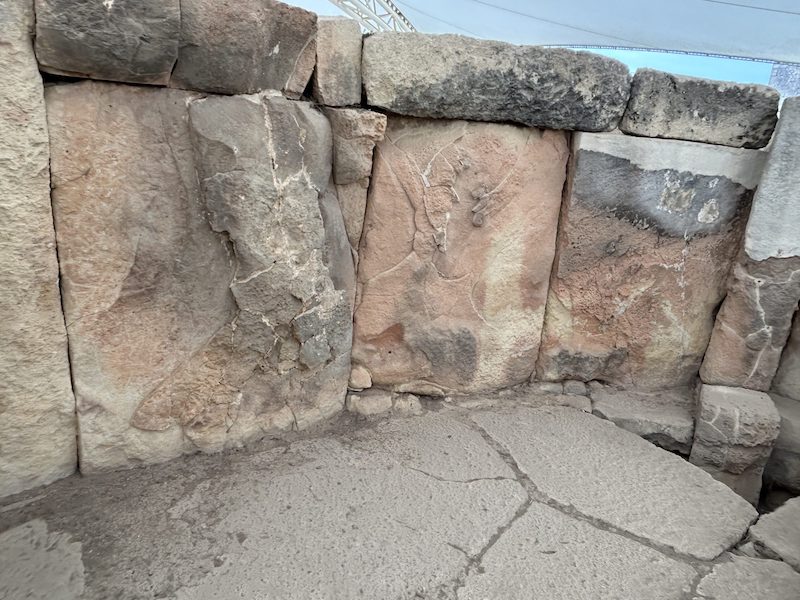
Coloured animal drawings at Tarxien Prehistoric Complex/ Photo by Carolyn Ray
Travel in Malta
Both Bolt and Uber operate in Malta and I found them reliable and cost-competitive. (Download the apps in advance).
Malta ferry or bus: Buy a Talijandra pass at the airport for $6 which includes a complimentary pass. You can use the card on ferries and buses. The express bus from the airport (X1, X2 etc) is 2.50 euros, and took about an hour to Saint Julian. Buses take cash (Euros). From Sliema to Valletta, the bus across town to Three Cities is about $2 or $6 return.
Taxis: The island is served by both Bolt and Uber which are very affordable – from Saint Julians to Valletta is about $8 one way, from Valletta to Airport $10. Download your apps in advance.
Renting a car in Valletta: Car rental is cheap, at about $8 a day from Hertz, then add-ons like insurance take it up to $40. There is a set $6 flat fee to enter each city on the island. If you rent, remember that you’re driving on the right-hand side of the road. Like those in Italy, gas stations use pre-paid machines that accept bills and cards. It’s a good idea to have cash on hand after 6 pm. Find a car to rent here.
Where to stay in Malta
There are several different communities near Valletta Old Town. I stayed in Saint Julians a beautiful fifth-floor apartment with views of the bay. If I go back, I’d like to try Three Cities as it feels less touristy. For a first-time traveller, I suggest staying in Valletta. Some reader-recommended hotels include Palazzo Rosario boutique hotel, Hotel Una Palace, or Casa Rocca Piccola. Find a place to stay on VRBO or on booking.com here.
Read More about Europe in the Low Season
JourneyWoman Webinar: Travel to France and Italy With Best-Selling Authors on March 26
Learn how you can travel to France and Italy with best-selling authors on this special webinar presented by Absolutely Southern France.
Hotels We’d Travel the World For, Just to Stay Again
Travel around the world with women-recommended places to stay that will take you to boutique hotels, guesthouses, retreats and more!
Literary Adventures: Travel in France and Italy With Best-Selling Authors
Loved the book? Now you can join a trip with best-selling authors to France and Italy, curated by Absolutely Southern France.







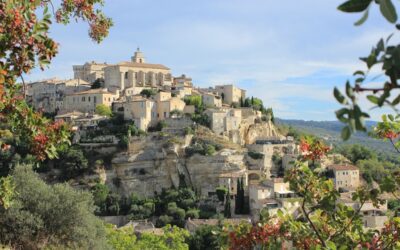
0 Comments
We always strive to use real photos from our own adventures, provided by the guest writer or from our personal travels. However, in some cases, due to photo quality, we must use stock photography. If you have any questions about the photography please let us know.
Disclaimer: We are so happy that you are checking out this page right now! We only recommend things that are suggested by our community, or through our own experience, that we believe will be helpful and practical for you. Some of our pages contain links, which means we’re part of an affiliate program for the product being mentioned. Should you decide to purchase a product using a link from on our site, JourneyWoman may earn a small commission from the retailer, which helps us maintain our beautiful website. JourneyWoman is an Amazon Associate and earns from qualifying purchases. Thank you!
We want to hear what you think about this article, and we welcome any updates or changes to improve it. You can comment below, or send an email to us at [email protected].